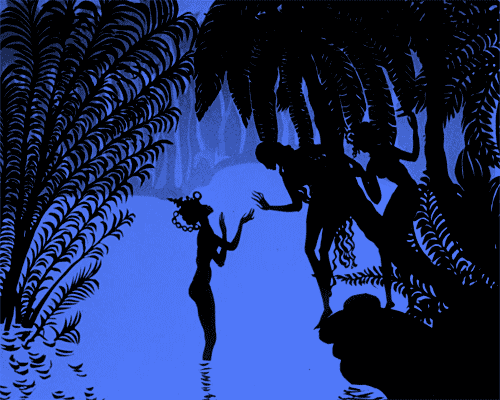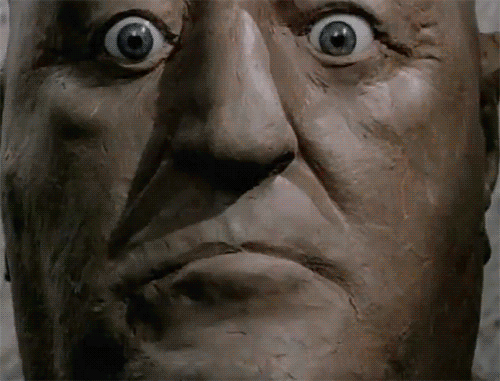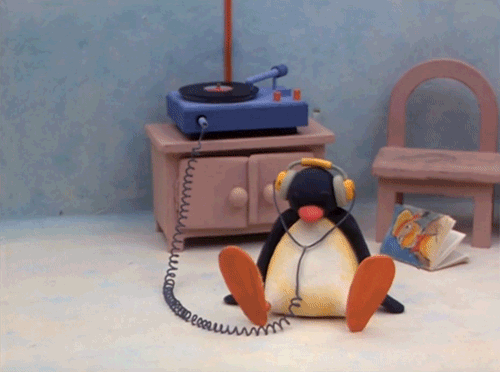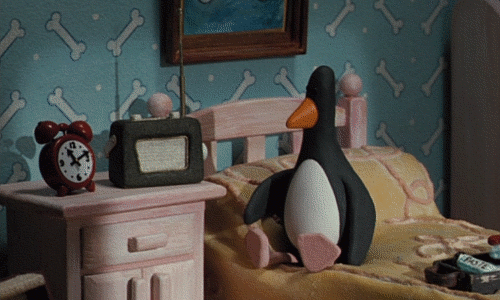originally posted at https://canmom.tumblr.com/post/649186...
It’s here! The big five zero! Almost a year straight of animation every Thursday! Fucking wild lmao.
This week, the focus is on a particular technique that’s so broad we can only give a little bit of scattershot overview… it’s stop motion animation!

Stop motion is where you arrange objects in a scene to take a photo for each frame, and then play your photos back at film speed.
It’s one of the oldest forms of animation, and it has a distinctive look: just like with drawings, there is no motion blur, giving every frame a kind of ultra clarity. The objects you animate can be pretty much anything: from everyday objects and paper cutouts to elaborate clay sculptures built around metal armatures or even living human actors (a technique known as ‘pixilation’).
And for all that it has some advantages over drawings (like with CGI, perspective is taken care for you!) it has plenty of finicky aspects: you gotta be careful not to jog the elements of your scene, leave fingerprints in the clay, etc. etc., and there’s no onion skins to help you make sure your arcs and easing etc. are good…

To give a briefer version of that very detailed history, the earliest stop motion animations actually predate film altogether, using stroboscopic discs like the Phenakistiscope, but things naturally really took off with the invention of film cameras. Early filmmakers used tricks like pausing filming to swap an object in or out of shot (the ‘stop trick’ or ‘substitution splice’), and stop-motion seems like a pretty natural evolution of that.
So in the early 1900s you get films like those of this moustachioed chap, Spanish filmmaker Segundo de Chomón, whose pixilation gif you can see there - and who was also one of the first people to animate in clay:
…and numerous others like J Stuart Blackton (who cut stop motion with live action in films like The Haunted Hotel) and Émile Cohl (who animated with objects from toys to Japanese masks).
There’s lots more stop motion films in the silent era - considerably more than ‘traditional’ hand drawn animated films which were only barely beginning to get started! One funny example that jumped out to me is Władysław Starewicz, who was trying to film beetles - but they wouldn’t fuck on camera and kept dying under the film lights, so he resorted to replacing their legs with wires and animating their corpses. Sadly this first instance of stop motion beetle porn has been lost to history. Also lost is the work of Helena Smith Dayton, who apparently adapted Romeo and Juliet in claymation - which sounds like quite an undertaking!

By this point, animated films were starting to hit ‘feature length’. The first to arrive were stop-motion adjacent techniques, such as the incredible cutout silhouette animation of Lotte Reiniger in The Adventures of Prince Achmed. Most of the early feature-length animated films also used cutout animation.
Starewicz, who had by now moved from Russia to Paris, returns to the story now with Le Roman de Renard (The Tale of the Fox) (filmed by 1930, soundtrack added and released in 1937). This is technically not the first stop-motion feature-length film, predated a decade earlier by Argentinian film La Carmen Criolla o Una noche de gala en el Colón (1918) by Andrés Ducaud, but Ducaud’s film has been lost and Starewicz’s hasn’t.
Renard is an adaptation of the classic story collection of trickster-character Renard the Fox, and presents itself in a kind of storybook-like format. By now we’re well beyond the shaky, brief experiments of the early stop motion films: Starewicz’s characters have detailed models and are capable of fairly complex expressions, and cameras have gotten much, much fancier, with much more stable lighting allowing detailed outdoor scenes and remarkably lifelike animation of birds and foliage.
From here, stop motion really takes off, and we’ll zero in on a few specific strands. But I’ll briefly mention some little curiosities: one guy George Pal specialised in ‘replacement animation’: instead of adjusting a posable clay figure or puppet slightly for each frame in a sequence, he would carve an entire fresh wooden sculpture in each frame… but don’t get too excited, one of the main puppetoon series was straight-up a collection of minstrel archetypes because hoo boy animation history is racist as shit! :/
Meanwhile, before the last few decades of CGI, Hollywood films would usually turn to stop motion for special effects… and in the 50s those effects, especially when they concerned creatures, were pretty much synonymous with one guy: animator Ray Harryhausen. Harryhausen would create little articulated puppet statues, and stop-motion animate them singlehandedly, working long shifts under carefully matched lighting. The studio could then composite them with the footage of live actors using travelling mattes and multiple exposures to clone the different layers onto a new film.
(The above interview shows some of his especially elaborate effects shots on Jason and the Argonauts, along with the miniature sets and models, and he talks about some of the difficulties of stop motion animation.)
Later on, the Americans would also put out some very visually distinct stop motion in the works of Henry Sellick of The Nightmare Before Christmas, Coraline, etc. I’m probably going to devote a full Animation Night to him down the line, so more on that anon!

Now, the 60s! On the other side of the Iron Curtain, stop motion animation was taking off in Czechoslovakia in a big way. Most famous and influential of the Czech animators is filmmaker Jan Švankmajer, who got his start making black comedy short films consciously taking after the Surrealists. His early short films (like Dimensions of Dialogue (1983) in the gif above) were mostly fully stop motion; later on he made some renowned feature films like Alice (1988) and Faust which combine it with live action; his most recent films don’t use animation at all.
It’s honestly a bit tricky to get much of a picture of Švankmajer’s life and influences. From his birth to the 1990s, Czechoslovakia was ruled by a Leninist party, but his work only once addressed this directly, in a BBC-funded propaganda film made shortly after the fall of the USSR which naturally condemns Stalinism - so he probably thought that sucked. But while it’s easy to find various academic interpretations of his films, it’s harder to get the guy’s own words! But perhaps he might prefer it that way.
Anyway what draws me to Švankmajer is that his brand of surrealism seems to include a lot of weird body stuff. Sometimes he will - much like Starewicz above with his bugs and beetles - go as far as using actual animal tissue in animation, such as in Meat Love (1988) which depicts two cuts of meat on a date. But anyway, you know that stuff gets me, from ero-guro to Lloyd’s Lunchbox and Aeon Flux, anything that does something interesting with the physical grossnesses of occupying a body. And stuff like Dimensions of Dialogue definitely scratches that itch.

Another country with a strong tradition of stop-motion is… oddly enough, the shithole I happen to live in. The UK, while it hasn’t made a significant traditionally animated film since Watership Down and When the Wind Blows, produced a pretty vast amount of kids’ TV with stop-motion animation in the 60s and 70s (stereotypically, with a nice posh RP narrator to make everything cozy and throwing in a few jokes for the parents), often collaborating with studios from other European countries. Of course, some examples of ‘classic British kids’ animation’ are actually only tenuously ‘British’ - The Magic Roundabout (1965-77) is actually a French animated series dubbed with an original script.
Whether by nostalgia or just being weird, many of these shows have managed to achieve a kind of cult status. Examples include Terry Brain’s series The Trap Door (1984) (about clay monsters in a colourfully chaotic castle set), or The Clangers (1969-72, 74) (mouse things whistle at each other on the moon), as well as, sigh, Thomas the Tank Engine (1984-2021) (terrorised anthrophomorphic trains struggle to produce in a sealed dystopia), or The Wombles (1973-75) (twee Britishness at its most suffocating - as an antidote, one might want to look into the Borribles, a kind of chaotic ACAB satire of the Wombles, which would of course never see an animated adaptation.)
Since the 80s, this particular kind of stop motion has declined (with old stop motion series largely being replaced with computer animation if they keep going) - but occasionally you get charming exceptions the Swiss-British collaboration Pingu (1990-2006), in which claymation penguins who speak a nonsense language get up to surreal sight gags.

And then, of course, we hit Aardman Animations! Based in Bristol - not far from where I grew up! clearly i was doomed - these guys brought an especially high technical standard of character animation and filming to claymation. They’re best known for the Wallace and Gromit series about a cohabiting gay furry couple (tell me I’m wrong) of an eccentric, cheese-loving inventor and a more practically-minded dog. Beginning in 1989 with A Grand Day Out, the series saw three more 20-minute-ish shorts and then a feature film, of which the best known is most likely The Wrong Trousers (1993), which ada describes better than I could:
My lodger(??penguin) has driven my husband (35m) from my home and entrapped me in remote control trousers to enable a bank heist. AITA?
This launched a spinoff series Shaun the Sheep, and generally like it seems the Aardman formula can’t miss.
Outside of Wallace and Gromit, they are also known for Chicken Run (2000), a parody of WWII escape movies like The Great Escape with anthro chickens trying to get out of a farm. It’s a good movie - though for some reason I remember most the scene early in the film where a chicken is eaten and the other chickens sea its ribs, which was quite upsetting for like eight year old bryn (and now i draw guro and subject my friends to lloyd’s lunchbox for fun! weird how things turn out).

Of course, the UK is hardly the only country to have a long tradition of stop-motion kids’ animation - just one I have reason to know! I should definitely mention the East German (now just German) stop-motion series [Unser ]Sandmännchen, or [Little ]Sandman, which has the virtue of being both the longest-running animated series ever, running without pause since 1959, and also easily the TV series with more episodes than any other at, get this, 22,200 and counting.
Along with these TV shows, there’s plenty of stop motion in the indie short film side of things. These include the short films by ‘PES’ (Adam Pesapene), whose main shtick is to stop motion everyday objects as if they were similar looking foods:
…which means lots of inventive visual humour.
Kirsten Lepore is one of my absolute fave indie stop motion animators, and honestly I could try to describe her thing but just watch that video, it’s only a couple of minutes. (She’s also the creator of the Story From North America video, which I’ve played in Mogs’s list more than a couple of times!)
Guldies is one we’ve covered before on the first indie animator night, but check out his weirdly hyperdetailed heads morphing into things or like, various bad things happening to little guys. This is only scratching the surface: poring over my YT history I also find strange little things like this guy making military history videos out of LEGO. And of course I introduced DawnOfNSSD and their titty bionicles a couple weeks back. Then from Japan there’s the charmingly silly Chainsaw Maid series by takena, which is exactly what you’d expect, and the recent Pui Pui Molcar, which puts guinea pig cars in various movie pastiches idek….
So what’s the plan for tonight? I can only do a somewhat arbitrary slice of stop motion film, but our main features are going to be Alice and Dimensions of Dialogue by Jan Švankmajer and The Wrong Trousers/A Close Shave by Aardman. The rest is going to be a selection of short films, maybe a few little surprises like this film I finally tracked down out of an obscure subconscious corner (which is CGI, but centres on a grotesque kind of stop motion).
So! Animation Night 50 begins in about half an hour at 7pm UK time, at the usual place, twitch.tv/canmom! I hope to see you there! ^^
Comments